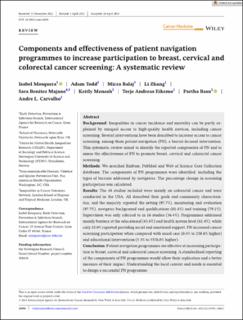| dc.contributor.author | Mosquera, Isabel | |
| dc.contributor.author | Todd, Adam | |
| dc.contributor.author | Zhang, Li | |
| dc.contributor.author | Benitez Majano, Sara | |
| dc.contributor.author | Mensah, Keitly | |
| dc.contributor.author | Eikemo, Terje Andreas | |
| dc.contributor.author | Basu, Partha | |
| dc.contributor.author | Balaj, Mirza | |
| dc.date.accessioned | 2023-08-14T08:41:07Z | |
| dc.date.available | 2023-08-14T08:41:07Z | |
| dc.date.created | 2023-05-28T23:58:36Z | |
| dc.date.issued | 2023 | |
| dc.identifier.issn | 2045-7634 | |
| dc.identifier.uri | https://hdl.handle.net/11250/3083723 | |
| dc.description.abstract | Background
Inequalities in cancer incidence and mortality can be partly explained by unequal access to high-quality health services, including cancer screening. Several interventions have been described to increase access to cancer screening, among them patient navigation (PN), a barrier-focused intervention. This systematic review aimed to identify the reported components of PN and to assess the effectiveness of PN to promote breast, cervical and colorectal cancer screening.
Methods
We searched Embase, PubMed and Web of Science Core Collection databases. The components of PN programmes were identified, including the types of barriers addressed by navigators. The percentage change in screening participation was calculated.
Results
The 44 studies included were mainly on colorectal cancer and were conducted in the USA. All described their goals and community characteristics, and the majority reported the setting (97.7%), monitoring and evaluation (97.7%), navigator background and qualifications (81.4%) and training (79.1%). Supervision was only referred to in 16 studies (36.4%). Programmes addressed mainly barriers at the educational (63.6%) and health system level (61.4%), while only 25.0% reported providing social and emotional support. PN increased cancer screening participation when compared with usual care (0.4% to 250.6% higher) and educational interventions (3.3% to 3558.0% higher).
Conclusion
Patient navigation programmes are effective at increasing participation to breast, cervical and colorectal cancer screening. A standardized reporting of the components of PN programmes would allow their replication and a better measure of their impact. Understanding the local context and needs is essential to design a successful PN programme. | en_US |
| dc.language.iso | eng | en_US |
| dc.publisher | Wiley | en_US |
| dc.rights | Navngivelse 4.0 Internasjonal | * |
| dc.rights.uri | http://creativecommons.org/licenses/by/4.0/deed.no | * |
| dc.title | Components and effectiveness of patient navigation programmes to increase participation to breast, cervical and colorectal cancer screening: A systematic review | en_US |
| dc.title.alternative | Components and effectiveness of patient navigation programmes to increase participation to breast, cervical and colorectal cancer screening: A systematic review | en_US |
| dc.type | Peer reviewed | en_US |
| dc.type | Journal article | en_US |
| dc.description.version | publishedVersion | en_US |
| dc.source.journal | Cancer Medicine | en_US |
| dc.identifier.doi | 10.1002/cam4.6050 | |
| dc.identifier.cristin | 2149876 | |
| dc.relation.project | Norges forskningsråd: 288638 | en_US |
| cristin.ispublished | true | |
| cristin.fulltext | preprint | |
| cristin.qualitycode | 1 | |

